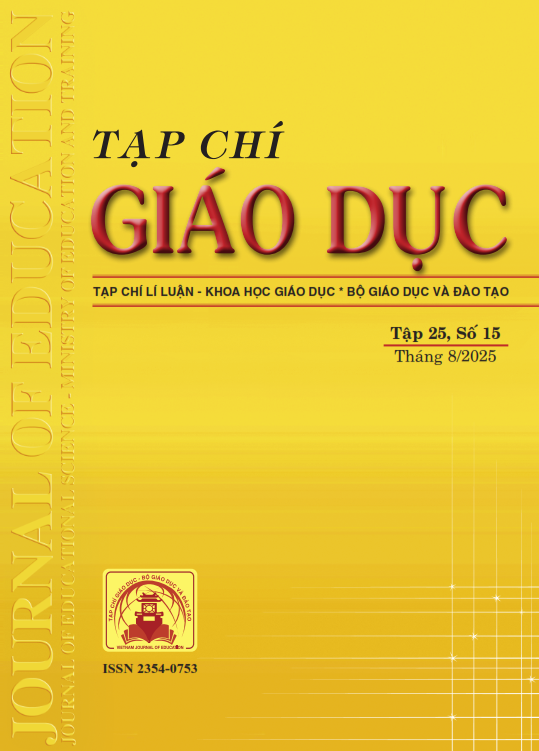Vận dụng chu trình 5E trong dạy học một số yếu tố thống kê dạng biểu đồ tranh ở tiểu học
Tóm tắt
Since Vietnam’s 2018 General Education Curriculum for Mathematics was introduced, there has been a growing emphasis on teaching methods that promote learners’ active engagement, autonomy, and capacities to explore and discover knowledge. Among these, the 5E instructional model stands out for its advantages in fostering intrinsic motivation and supporting learners in actively constructing their own understanding, ultimately leading to improved learning outcomes. This paper examines the application of the 5E model in teaching certain statistical elements, particularly picture graphs, at the primary school level. Using theoretical research and content analysis methods, the study proposes a clear instructional process and practical strategies for implementing the 5E model in real-world classroom settings. The findings provide both a theoretical basis and practical guidance, serving as a valuable resource for educators, specialists, and policymakers in enhancing the quality of mathematics education at the primary level.
Tài liệu tham khảo
Alvermann, D. E., Smith, L. C., & Readence, J. E. (1985). Prior knowledge activation and the comprehension of compatible and incompatible text. Reading Research Quarterly, 420-436.
Ambrose, S. A., Bridges, M. W., DiPietro, M., Lovett, M. C., & Norman, M. K. (2010). How learning works: Seven research-based principles for smart teaching. John Wiley & Sons.
Ausubel, D. P. (1960). The use of advance organizers in the learning and retention of meaningful verbal material. Journal of Educational Psychology, 51(5), 267.
Bộ GD-ĐT (2018). Chương trình giáo dục phổ thông môn Toán (ban hành kèm theo Thông tư số 32/2018/TT- BGDĐT ngày 26/12/2018 của Bộ trưởng Bộ GD-ĐT).
Bower, G. H., Clark, M. C., Lesgold, A. M., & Winzenz, D. (1969). Hierarchical retrieval schemes in recall of categorized word lists. Journal of Verbal Learning and Verbal Behavior, 8(3), 323-343.
Bybee, R. W. (2015). The BSCS 5E instructional model: Creating teachable moments. Arlington, TX: NSTA Press, National Science Teachers Association.
Bybee, R. W., Taylor, J. A., Gardner, A., Van Scotter, P., Powell, J. C., Westbrook, A., & Landes, N. (2006). The BSCS 5E instructional model: Origins and effectiveness. Colorado Springs, Co: BSCS, 5, 88-98.
Carr, S. C., & Thompson, B. (1996). The effects of prior knowledge and schema activation strategies on the inferential reading comprehension of children with and without learning disabilities. Learning Disability Quarterly, 19(1), 48-61.
Dương Thị Kim Oanh, Phạm Thị Trúc Ly (2021). Tổ chức dạy học STEM theo mô hình 5E trong dạy học bài “Sự điện li của nước. PH. Chất chỉ thị Axít - Bazơ” (Hóa học 11). Tạp chí Giáo dục, 515, 23-28.
Edelson, D. C. (2001). Learning‐for‐use: A framework for the design of technology‐supported inquiry activities. Journal of Research in Science Teaching, 38(3), 355-385.
Garcia I Grau, F., Valls, C., Piqué, N., & Ruiz-Martín, H. (2021). The long-term effects of introducing the 5E model of instruction on students’ conceptual learning. International Journal of Science Education, 43(9), 1441-1458. https://doi.org/10.1080/09500693.2021.1918354
Hattan, C., Singer, L. M., Loughlin, S., & Alexander, P. A. (2015). Prior knowledge activation in design and in practice. Literacy Research: Theory, Method, and Practice, 64(1), 478-497.
Healy, A. F., Clawson, D. M., McNamara, D. S., Marmie, W. R., Schneider, V. I., Rickard, T. C., Crutcher, R. J., King, C. L., Ericsson, K. A., & Bourne Jr, L. E. (1993). The long-term retention of knowledge and skills. In Psychology of Learning and Motivation (Vol. 30, pp. 135-164). Elsevier.
Huỳnh Mỹ Phụng, Nguyễn Phú Lộc (2023). Kết hợp mô hình 5E với phương pháp dạy học khám phá vào dạy học “Quy tắc cộng” cho học sinh lớp 10 ở trường trung học phổ thông. Tạp chí Giáo chức Việt Nam, 195,189-191.
Karpicke, J. D., & Roediger III, H. L. (2008). The critical importance of retrieval for learning. Science, 319(5865), 966-968.
Kimball, D. R., & Holyoak, K. J. (2000). Transfer and expertise. The Oxford Handbook of Memory, 109-122.
Kirschner, P. A., Sweller, J., & Clark, R. E. (2006). Why minimal guidance during instruction does not work: An analysis of the failure of constructivist, discovery, problem-based, experiential, and inquiry-based teaching. Educational Psychologist, 41(2), 75-86.
Lê Thị Hoài Châu (2020). Dạy học thống kê - xác suất ở Tiểu học. NXB Đại học Sư phạm Thành phố Hồ Chí Minh.
Nguyễn Thị Loan (2020). Vận dụng chu trình kiến tạo 5E vào dạy học một số chủ đề toán cho sinh viên khối trường cao đẳng kinh tế - kĩ thuật. Luận án tiến sĩ Khoa học giáo dục, Trường Đại học Sư phạm - Đại học Thái Nguyên.
Nguyễn Thị Thanh Tuyên (2024). Vận dụng mô hình 5E trong dạy học giải các bài toán thực tiễn ở lớp 8 bằng định lí Thales. Tạp chí Giáo dục, 24(13), 18-22.
Phạm Thị Hồng Hạnh, Chu Thị Mai Quyên (2020). Sử dụng mô hình 5E thiết kế kế hoạch dạy học Chương 2, Hình học lớp 11 theo định hướng giáo dục STEM. Tạp chí Khoa học Giáo dục Việt Nam, 30, 19-24.
Ruiz-Martín, H., & Bybee, R. W. (2022). The cognitive principles of learning underlying the 5E Model of Instruction. International Journal of STEM Education, 9(1), 21. https://doi.org/10.1186/s40594-022-00337-z
Turan, S., & Matteson, S. M. (2021). Middle school mathematics classrooms practice based on 5E instructional model. International Journal of Education in Mathematics, Science, and Technology (IJEMST), 9(1), 22-39. https://doi.org/10.46328/ijemst.1041
Wigfield, A., & Eccles, J. S. (2000). Expectancy-value theory of achievement motivation. Contemporary Educational Psychology, 25(1), 68-81.
Wiliam, D. (2011). Embedded formative assessment. Solution Tree Press.
Tải xuống
Đã Xuất bản
Cách trích dẫn
Số
Chuyên mục
Giấy phép

Tác phẩm này được cấp phép theo Ghi nhận tác giả của Creative Commons Giấy phép quốc tế 4.0 .












